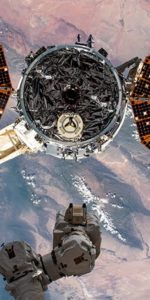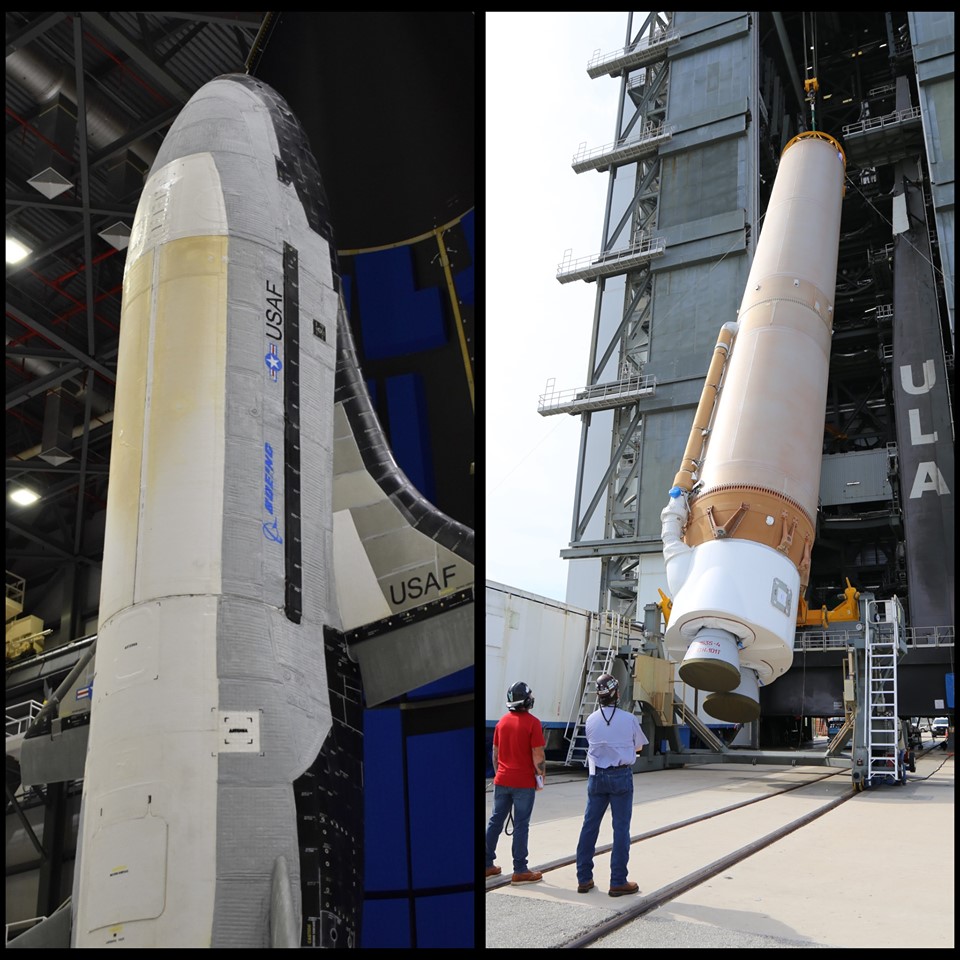
United Launch Alliance (ULA) has completed another significant step towards its next mission from the Space Coast, as a 197-foot-tall (60-meter) Atlas V booster now stands fully stacked and primed for its opening launch attempt in ten days’ time. Late last month, a “streamlined two-day process” completed the assembly of the giant rocket in the Vertical Integration Facility (VIF) at Space Launch Complex (SLC)-41 at Cape Canaveral Air Force Station, Fla. And earlier today (Wednesday, 6 May), the two-piece, “bisector” payload fairing—containing the Boeing-built X-37B mini-shuttle—was installed atop the booster.
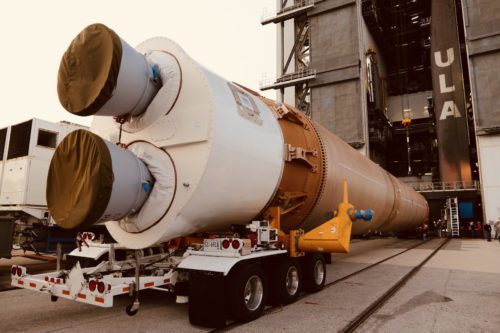
The 107-foot-long (32-meter) Common Booster Core (CBC) approaches the doorway of the Vertical Integration Facility (VIF) at Space Launch Complex (SLC)-41 during the recent Launch Vehicle On Stand (LVOS) processing milestone. Photo Credit: ULA
Liftoff of ULA’s third mission of 2020—which comes hard on the heels of February’s long-awaited Solar Orbiter and March’s flight of the last Advanced Extremely High Frequency (AEHF) satellite for the newly-formed U.S. Space Force—is tentatively planned for Saturday, 16 May. Designated U.S. Space Force (USSF)-7, the Atlas V will deliver the highly secretive X-37B into orbit for its sixth long-duration flight in a little more than a decade. Uniquely, the mission will also incorporate an aft-mounted “service module” to expand the spacecraft’s payload envelope.
“In today’s age of electrons, space systems track storms, locate stranded motorists, timestamp credit card transactions and monitor treaty compliance,” said Secretary of the Air Force Barbara Barrett. “Demonstrating the department’s innovation, this X-37B mission will host more experiments than any prior missions. This launch also demonstrates the department’s collaboration that pushes the boundaries for reusable space systems.”
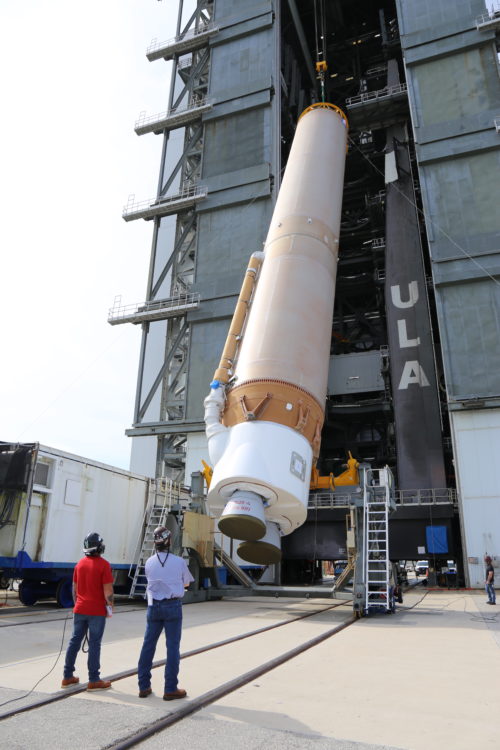
The dual nozzles of the RD-180 engine at the base of the CCB produce 860,000 pounds (390,000 kg) of propulsive yield at liftoff. Photo Credit: ULA
“The X-37B team continues to exemplify the kind of lean, agile and forward-leaning technology development we need as a nation in the space domain,” said U.S. Space Force Chief of Space Operations, Gen. John “Jay” Raymond. “Each launch represents a significant milestone and advancement in terms of how we build, test and deploy space capabilities in a rapid and responsive manner.”
Preparations for the flight entered high gear last October, when the 107-foot-long (32-meter) Common Core Booster (CCB) for the Atlas V arrived aboard ULA’s RocketShip vessel from the factory in Decatur, Ala. Also delivered to the Cape was the 41-foot-long (12.6-meter) Centaur upper stage. The two components immediately parted ways, with the CCB heading to the holding bay of the Atlas Spaceflight Operations Center (ASOC) for processing. With the steady worldwide march of the COVID-19 coronavirus having forced lengthy delays to several other missions from the East Coast, USSF-7 now stands in pole position as the next military flight for the U.S. Space Force, the youngest member of the United States armed services.
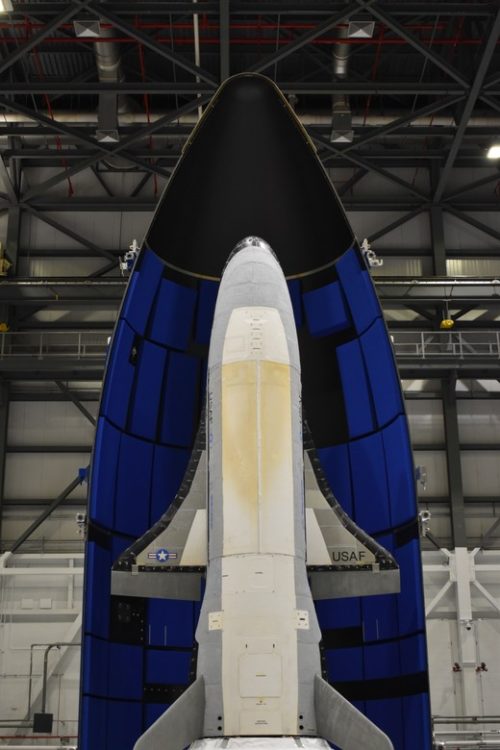
“Conducting the USSF-7 launch with the X-37B Orbital Test Vehicle was deemed critical to perform during this national emergency,” noted ULA in an update earlier Wednesday. “Personnel involved in the launch are following health guidelines such as wearing face coverings, adhering to physical distancing while on console and using virtual connections when possible.”
Just before dawn on 23 April, ULA began its Launch Vehicle On Stand (LVOS) milestone, which saw the Atlas V CCB transferred horizontally atop a semi-truck from the ASOC to the door of the VIF. It was hoisted upright by overhead cranes and secured onto the Mobile Launch Platform (MLP) by means of three support pedestals. Two days later, the Off-Site Vertical Integration (OVI) pre-assembled unit—which comprises the Centaur upper stage, the rocket’s inter-stage adapter and the lower half of the payload fairing—arrived at the VIF and were installed atop the CCB in a process which concluded Monday, 27 April.
“In the early years of Atlas V operations, each piece was added one-by-one to the rocket in the VIF by way of multiple days of crane operations,” ULA explained of the intricate procedure. “ULA has since moved to the more efficient process of connecting these pieces together in a separate facility and bringing the finished element to the VIF for one crane-lift.” With the final topping-off of the booster with the payload fairing and the X-37B on 6 May, the coming days will be spent performing integrated tests of the assembly stack.
The Atlas V booster for the USSF-7 mission will be flying for the seventh time in its so-called “501” configuration, equipped with a 16-foot-diameter (5-meter) payload fairing, no strap-on rockets and the single-engine Centaur upper stage. This particular configuration can lift around 17,800 pounds (8,100 kg) to low-Earth orbit and up to 8,300 pounds (3,770 kg) to geostationary altitude has been used rather sparingly over the years. It saw its last mission to deliver the fourth X-37B to orbit back in May 2015.
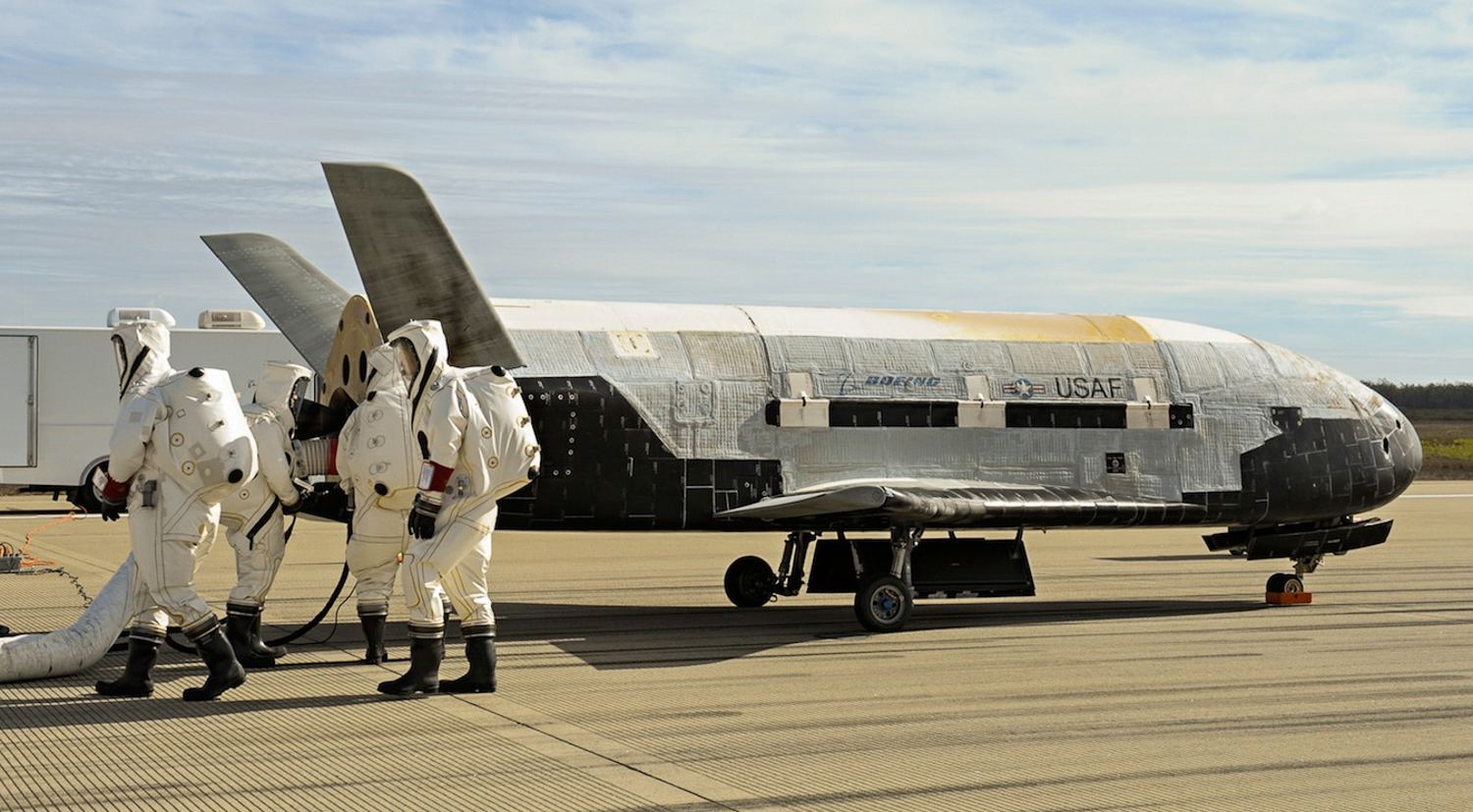
Indeed, four Atlas V 501 missions—including its very first outing, way back in April 2010—have been used exclusively to lift X-37Bs, with two others dedicated to launching a pair of classified payloads for the National Reconnaissance Office. In fact, with the exception of the most recent X-37B, which rode atop a SpaceX Falcon 9 in late 2017, each of these top-secret mini-shuttle missions have flown atop the Atlas V 501.
The physical likeness between the X-37B and NASA’s now-retired Space Shuttle is somewhat misleading. Notably, it is significantly smaller than its predecessor, measuring some 29 feet (8.8 meters) in length and with a wingspan of just less than 15 feet (4.5 meters). Once in orbit, the spacecraft deploys an array of gallium arsenide solar cells which—when combined with the power output from a set of lithium-ion batteries—allow it to remain aloft for far longer than its crew-carrying cousin.
The X-37B’s payload bay measures 7 feet (2.1 meters) long and 4 feet (1.2 meters) in diameter and can accommodate cargoes weighing between 500 pounds (220 kg) and 660 pounds (300 kg). An advanced avionics suite and airframe, together with electromechanical actuators and autonomous guidance controls, has focused the spacecraft’s mandate onto “risk reduction, experimentation and operational concept development for reusable vehicle technologies in support of long-term developmental space objectives”.
Originally devised as a NASA-led initiative, with development contracts awarded to Boeing in 1999, the program moved under military ownership when it was transferred to the Defense Aerospace Research Projects Agency (DARPA) in 2004.
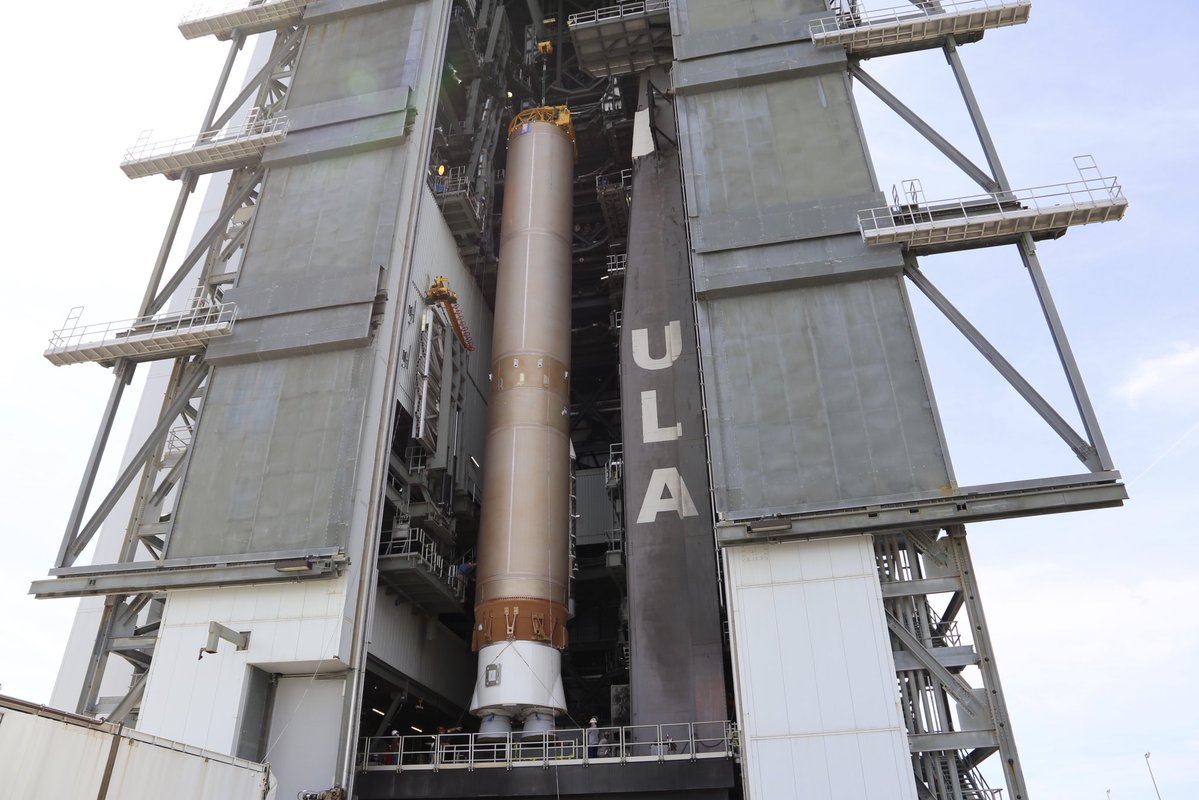
Atmospheric glide tests over the next two years led ultimately to an Air Force decision in late 2006 to develop its own variant of the spacecraft as the Orbital Test Vehicle (OTV) and the first mission flew from April-December 2010, logging 224 days in orbit. A second mission flew 468 days from March 2011 through June 2012, a third completed 675 days between December 2012 and October 2014 and a fourth wrapped up almost 718 days between May 2015 and May 2017.
More recently, the fifth X-37B launched atop SpaceX’s Falcon 9 in September 2017 and returned smoothly to Earth last 27 October, after 780 days aloft. All X-37B missions have launched from the Space Coast, with the first three returning to runway landings at Vandenberg Air Force Base, Calif., and the others terminating at the Shuttle Landing Facility (SLF) at the Kennedy Space Center (KSC).
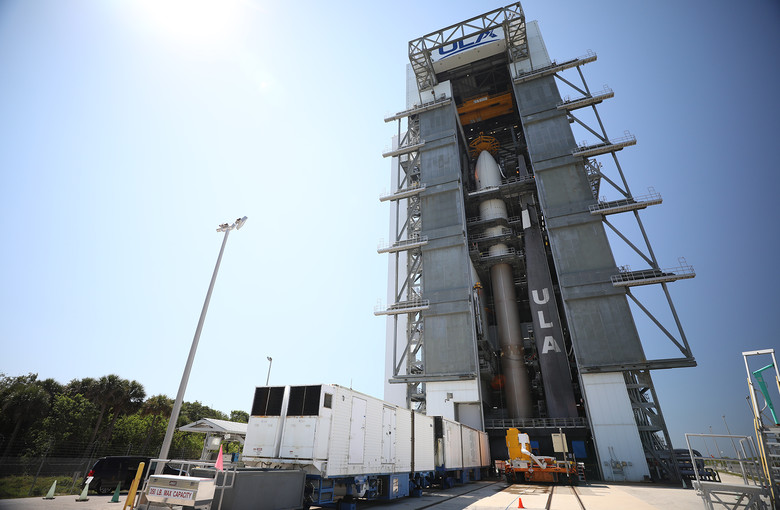
In spite of the secrecy, some snippets of information have crept in the public domain from those five classified missions. In December 2012, the X-37B became the first U.S. autonomous orbital vehicle to complete an end-of-mission runway landing, despite suffering a tire blowout.
The exact nature of its payloads and objectives have often been cloaked in the dry, seemingly meaningless technobabble that is characteristic of secret military missions, although X-37Bs have tested Aerojet Rocketdyne’s XR-5A Hall-effect ion thruster in support of the AEHF program and supported various NASA investigations focused on long-duration materials exposure in the harsh vacuum of low-Earth orbit. And during its most recent mission, which spent 25 months aloft, the X-37B expanded its envelope by flying to a much higher inclination and modified its own orbit using on-board propulsion.
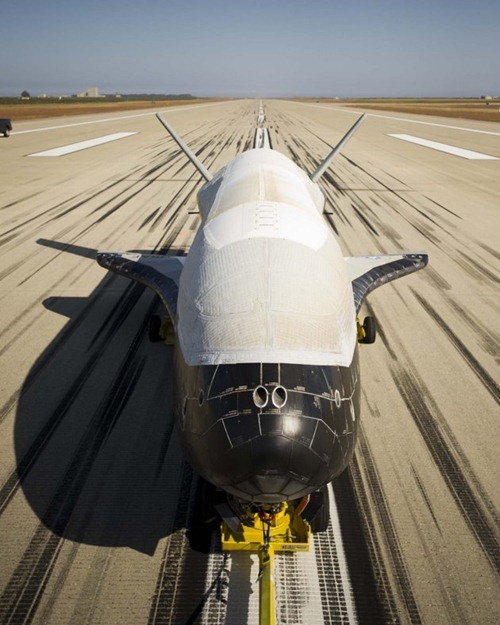
This month’s flight will be the first X-37B mission to use a service module for additional experiment-hosting capability. “This sixth mission is a big step for the X-37B program,” said Randy Walden, Director and Program Executive Officer for the Department of the Air Force Rapid Capabilities Office. “This will be the first X-37B mission to use a service module to host experiments. The incorporation of a service module on this mission enables us to continue to expand the capabilities of the spacecraft and host more experiments than any of the previous missions.”
The mission will deploy the FalconSat-8, a small satellite developed by the U.S. Air Force Academy and sponsored by the Air Force Research Laboratory to conduct several experiments on orbit. The FalconSat-8 is an educational platform that will carry five experimental payloads for USAFA to operate. In addition, a pair of NASA experiments will study radiation and other space effects on a materials sample plate and seeds used to grow food. Finally, the U.S. Naval Research Laboratory will transform solar power into radio frequency microwave energy which could then be transmitted to the ground.
Following the X-37B launch on 16 May, no less than six more missions are planned by ULA for the remainder of the year, bringing 2020’s total to nine. If achieved, this will be the greatest number of flights achieved by the organization since 2016. ULA CEO Tory Bruno recently tweeted that 29 booster cores—a mixture of Atlas V, Delta IV Heavy and as-yet-untried Vulcan hardware—are currently in work for upcoming missions.
A pair of Delta IV Heavy flights are targeted for June and later in the fall to deliver the NROL-44 and NROL-82 payloads for the National Reconnaissance Office; the first launching from the Cape and the second from Vandenberg. And four more Atlas V missions will boost NASA’s Perseverence rover towards Mars in July, refly an uncrewed CST-100 Starliner to the International Space Station (ISS) in the fall and launch NROL-101 for the National Reconnaissance Office and the multi-faceted USSF-8 for the U.S. Space Force.
.
.
FOLLOW AmericaSpace on Facebook and Twitter!
.
.
Missions » Air Force OTV » USSF-7 »




